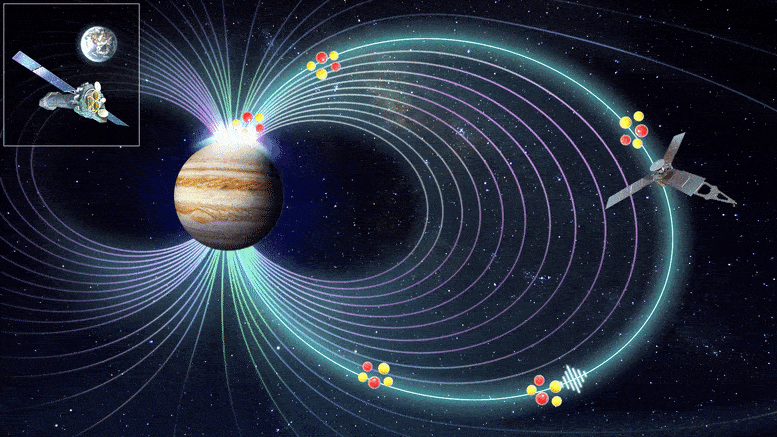Jupiter’s mysterious X-ray aurors have been described, ending a 40-year search for answers. For the first time, astronomers have seen Jupiter’s magnetic field compress, causing particles to heat up and directing them down along magnetic field lines into Jupiter’s atmosphere, triggering X-ray auroras. The link was created by combining in-situ data from NASA’s Juno mission with X-ray observations from ESA’s XMM-Newton. Photo credit: ESA / NASA / Yao / Dunn
–
A team of researchers has solved a decade-old mystery about how Jupiter creates spectacular X-rays every few minutes.
A joint research team led by UCL (University College London) has solved a decade-old mystery about how Jupiter creates spectacular X-ray beams every few minutes.
X-rays are part of Jupiter’s auroras – visible and invisible bursts of light that occur when charged particles interact with the planet’s atmosphere. Similar phenomena occur on Earth and create the Northern Lights, but Jupiter phenomena are much more powerful and release hundreds of gigawatts of energy, enough to briefly power all human civilization.*
In a new study published in Scientific progress, the researchers combined a close-up view of Jupiter’s surroundings from NASA’s Juno satellite, currently orbiting the planet, with simultaneous X-ray measurements from the European Space Agency’s XMM Newton Observatory (which is in orbit).
The research team, led by UCL and the Chinese Academy of Sciences, discovered that the X-rays are triggered by periodic oscillations of Jupiter’s magnetic field lines. These vibrations produce plasma waves (ionized gases) that cause heavy ion particles to “surf” along magnetic field lines until they hit the planet’s atmosphere and release energy in the form of X-rays.
An overlapping image of Jupiter’s poles from NASA’s Juno satellite and NASA’s Chandra X-ray telescope. To the left of Jupiter’s northern X-ray aurora projection (purple) is overlaid with Junocam’s image as seen from the North Pole. The right shows the southern counterpart. Photo credit: NASA Chandra / Juno Wolk / Dunn
–
Co-author Dr. William Dunn (UCL Mullard Space Science Laboratory) said, “We’ve been watching Jupiter produce X-ray aurorae for four decades, but we don’t know how that happens. We only know they are produced when ions hit the planet’s atmosphere.
“Now we know that these ions are transported by plasma waves – an explanation that has never been suggested before, although a similar process creates Earth’s own aurorae. Therefore, it could be a universal phenomenon that is present in many different environments in space.”
X-ray aurors occur at Jupiter’s north and south poles, often with clockwise order – during these observations, Jupiter produces X-rays every 27 minutes.
The charged ion particles that hit the atmosphere came from volcanic gases that flowed into space from the giant volcano on Jupiter’s moon, Io.
This gas is ionized due to collisions around Jupiter (its atoms are freed from electrons) and forms a ring of plasma that surrounds the planet.
For the first time, astronomers have seen Jupiter’s magnetic field compress, causing particles to heat up and directing them down along magnetic field lines into Jupiter’s atmosphere, triggering X-ray auroras. The link was created by combining in-situ data from NASA’s Juno mission with X-ray observations from ESA’s XMM-Newton. Photo credit: ESA / NASA / Yao / Dunn
Co-author Dr. Zhonghua Yao (Chinese Academy of Sciences, Beijing) said, “Now we have identified this fundamental process and there are many opportunities to study it further. A similar process is likely around Saturn, Uranus, Neptune and possibly also on exoplanets, with different types of charged particles ‘surfing’ in waves.”
Co-author Professor Graziella Branduardi-Raymont (UCL Mullard Space Science Laboratory) said, “X-rays are usually produced by very strong and violent phenomena such as black holes and neutron stars, so it seems odd that ordinary planets also produce them.
“We will never be able to visit black holes because they are beyond space travel, but Jupiter is at our doorstep. With the arrival of the Juno satellite in Jupiter’s orbit, astronomers now have a fantastic opportunity to get up close and personal with the X-ray-generating environment.”
For the new study, the researchers analyzed continuous 26-hour observations of Jupiter and its surroundings by the Juno and XMM-Newton satellites.
They found a clear correlation between waves in plasma recorded by Juno and X-ray auroral eruptions recorded by XMM-Newton at Jupiter’s north pole. Then they used a computer model to confirm that the waves would push the heavy particles into Jupiter’s atmosphere.
Why the magnetic field lines periodically oscillate is unclear, but the oscillations could result from interactions with the solar wind or from high-speed plasma currents in Jupiter’s magnetosphere.
Jupiter’s magnetic field is very strong – about 20,000 times that of Earth’s – and therefore its magnetosphere, the area controlled by this magnetic field, is very large. If seen in the night sky, it would cover an area several times the size of our moon.
This work was supported by the Chinese Academy of Sciences, China National Foundation for Natural Sciences, UK Science and Technology Facility Council (STFC), Royal Society and Natural Environment Research Council, as well as ESA and NASA.
* Jupiter’s X-ray aurora alone releases about one gigawatt, which a power plant can generate over several days.
Reference: 9 July 2021, Scientific progress.
DOI: 10.1126 / sciadv.abf0851
–


